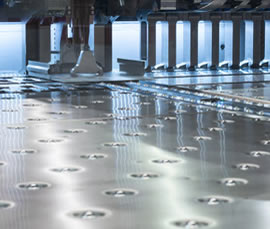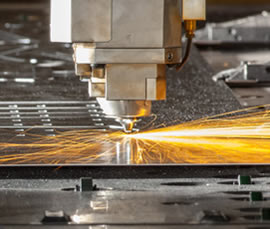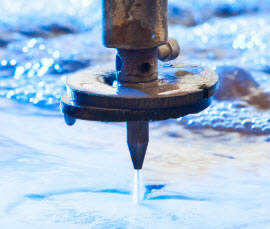Custom Cutting Capabilities 
 Metal and plastic manufacturing and fabrication to finished goods almost always involves the cutting of raw material. Large sheets or blocks of material must be reduced to “blanks” or “billets” for ease of handling or the finishing process.
Metal and plastic manufacturing and fabrication to finished goods almost always involves the cutting of raw material. Large sheets or blocks of material must be reduced to “blanks” or “billets” for ease of handling or the finishing process.
Fabricated typically denotes a “blank” that is cut from a flat sheet and formed or shaped by other processes to make a finished part. Billets are typically square blocks of material and are considered “machined”. Here you will find information on the different methods of cutting fabricated and machined parts.
Torch Cutting
For very thick materials the OXY-Acetelyne torch on an automated cutting table is the fastest way to make rough shapes. The finished edge is quite rough in most cases and requires additional finishing. This is made more difficult because the cut edge is made harder to mill or machine by the process. Very large fabrications like oil wells or military vehicles see products that start on the cutting torch.
Wire EDM
The slowest but most accurate of the cutting processes, the wire machine can cut perfectly square inside corners and cut thick sections of very hard steel. Commonly used in the past to cut tooling die sections, it has applications today because of it’s accuracy.
Stamping
 A process by which very large and powerful presses are integrated with “stamping dies/tools ” to produce parts. Presses can utilized with a “one out hand fed die”, “mechanical transfer”, or “progressive die”.
A process by which very large and powerful presses are integrated with “stamping dies/tools ” to produce parts. Presses can utilized with a “one out hand fed die”, “mechanical transfer”, or “progressive die”.
Like the name implies a one out hand fed die involves an operator putting a “blank” of steel in a stamping die which then cuts out the shape of the part… like a giant cookie cutter. Big parts like bumpers can be transferred from press to press by being mechanically transferred by a robot or conveyor. Progressive dies use those big coils of steel you see on flatbed trucks.
The coil is loaded into a cradle where it revolves. The material passes through a feeder and straightener and then into the press where it goes through a progressive series of cuts and forms to make a finished part. While tooling for stamping dies takes months and capital investment, it typically produces parts at the lowest cost.
Laser Cutting
 A common method for cutting both simple and intricate shapes in everything from fabric to steel is the laser. The laser is fast and accurate in thinner material but runs out of efficiency when you get to material much over a quarter inch thick. Since it produces a heat effect in the edge of the parts it may change the material properties. The higher the wattage of the laser the thicker the material it can cut.
A common method for cutting both simple and intricate shapes in everything from fabric to steel is the laser. The laser is fast and accurate in thinner material but runs out of efficiency when you get to material much over a quarter inch thick. Since it produces a heat effect in the edge of the parts it may change the material properties. The higher the wattage of the laser the thicker the material it can cut.
The edge left by the laser cut is not always of the quality required for finished goods, especially when the material is over 1/8 of an inch thick. Because it used in a number of industries, lasers are common, however the skills to use them are not.
Flat Metal Cutting
As you will see there are a lot of different ways to cut flat metal. The best process is often dictated by the quantity of parts required, the material being cut, and the purpose of the finished part. While most manufacturers will try to fit cutting requirements to the machines they operate, that is rarely the lowest cost. Finding the vendor with the best process and available capacity is the key to best value. Here is a review of flat metal fabrication cutting processes.
Plasma Cutting
In between the laser and the torch is plasma cutting. Using a stream of hot gasses it is fast and accurate. It fills the gap in making rough shapes in material from 1/16 of an inch up to about 1/8 of an inch.
Shearing
Related to making parts in high volume like seen in automotive applications, shearing is typically done by those who supply raw material. It is like a huge scissor that will cut the span of large sheets quickly. If you wanted to reduce a sheet 96 inches long to 1 inch strips or create many squares with just a few cuts, the shear will do just that. Shearing tends to leave a burr along the cut edge and is nearly always used to make “blanks” for further processing.
Water Jet Cutting
 Because it cuts very thick materials without heat and leaves a clean trim edge the waterjet is used in a wide variety of applications.
Slower than the laser but capable of cutting materials several inches thick, the water jet uses a high pressure nozzle carrying a mixture of water and sand. It produces no toxic gases nor does it discolor the material with heat transfer.
Because it cuts very thick materials without heat and leaves a clean trim edge the waterjet is used in a wide variety of applications.
Slower than the laser but capable of cutting materials several inches thick, the water jet uses a high pressure nozzle carrying a mixture of water and sand. It produces no toxic gases nor does it discolor the material with heat transfer.
Updated:8/5/2020
Are you looking for custom manufacturing?
Submit an RFQ now!
